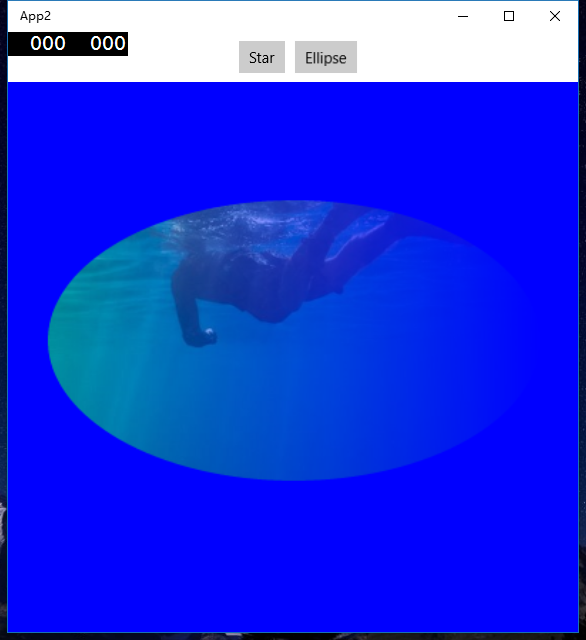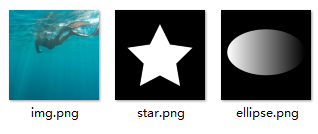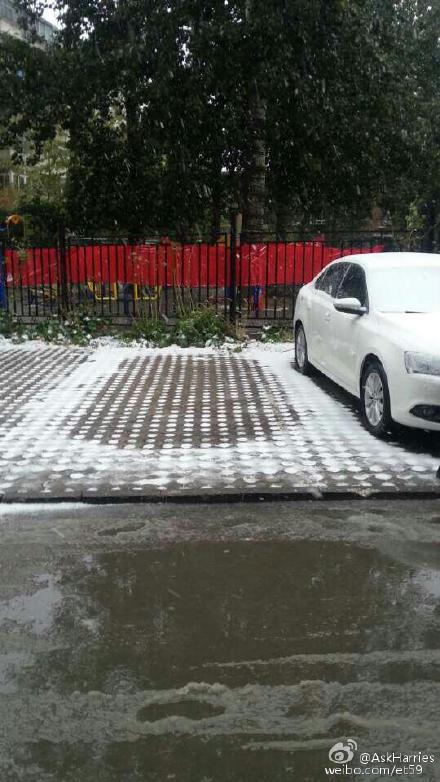UWP中的Direct2D
介绍
DirectX一直是Windows平台中高性能图形的代名词,自Win7开始,微软又推出了Direct2D技术,包装于Direct3D,但专注于2D图形,并且准备取代GDI这样的传统2D图形技术。对于Direct2D是怎么怎么好的具体描述,可以参考附录1.
不过Direct2D是基于COM技术的,看上去有些老旧的气息,而且是非托管的,似乎也和常见的.net语言有些隔阂。
不过微软也为我们提供了一个工具,一个跨越这一边界的工具,那就是 SurfaceImageSource 一族。该族中 SurfaceImageSource 继承自 Windows.UI.Xaml.Media.ImageSource , VirtualSurfaceImageSource 则继承自 SurfaceImageSource ,它们和 BitmapSource 在托管领域有着同样的地位。但同时这两个类又将触角伸到了COM的领域,分别可以query interface至 ISurfaceImageSourceNative 和 IVirtualSurfaceImageSourceNative ,再与Direct2D技术接轨。至此,XAML快速的界面技术,Direct2D高效的图形功能,得以合二为一。
本文将简单的介绍一下 SurfaceImageSource 的使用,为大家呈现一个高效图形应用的小例子(演示代码使用XAML和C++/CX)。
准备
代码主要是C++的(略有C++/CX扩展),因为要操作Direct2D和COM。大家可以根据需要自行包装自己的组件来调用。
用到了WIC(Windows Imaging Component)等技术,不过不是本文重点。
问题
熟悉WPF的读者可能想到,在classical desktop中使用的WPF,里面的一部分组件有一个神奇的属性, OpacityMask ,利用它可以给控件的渲染显示加上一个蒙版,实现各种透明渐变和不规则轮廓等等。
不过到了UWP(更早的从Windows Store App出现开始),虽然大家写的还是一样的XAML,但是 OpacityMask 属性没了。估计是为了性能考虑吧,不给用这么繁琐的东西了。
但难免有时要用到这样的功能,我们可以依靠高效的Direct2D图形技术来实现它。
看看效果先:


托管的SurfaceImageSource
上文已经提到了, SurfaceImageSource 是 Windows.UI.Xaml.Media.ImageSource 的子类,可以像使用 BitmapSource 一样使用它,赋给 BitmatBrush 的 ImageSource 什么的。这有点像 WriteableBitmap ,不过它却是操作Direct2D的入口。
我们先用XAML做一个这样的界面:
1 <Page x:Class="App2.MainPage" 2 xmlns="http://schemas.microsoft.com/winfx/2006/xaml/presentation" 3 xmlns:x="http://schemas.microsoft.com/winfx/2006/xaml" 4 xmlns:local="using:App2" 5 xmlns:d="http://schemas.microsoft.com/expression/blend/2008" 6 xmlns:mc="http://schemas.openxmlformats.org/markup-compatibility/2006" 7 mc:Ignorable="d"> 8 9 <Grid Background="{ThemeResource ApplicationPageBackgroundThemeBrush}"> 10 <Grid.RowDefinitions> 11 <RowDefinition Height="50" /> 12 <RowDefinition Height="*" /> 13 </Grid.RowDefinitions> 14 15 <Grid.Resources> 16 <Style TargetType="Button"> 17 <Setter Property="Margin" Value="10,0,0,0" /> 18 </Style> 19 </Grid.Resources> 20 21 <StackPanel HorizontalAlignment="Center" 22 Orientation="Horizontal" 23 x:Name="btns"> 24 <Button Tag="Assets/star.png">Star</Button> 25 <Button Tag="Assets/ellipse.png">Ellipse</Button> 26 </StackPanel> 27 28 <Rectangle Grid.Row="1" x:Name="canvas" /> 29 </Grid> 30 </Page>
Button的Tag记载的是用来做蒙版的图片,我们的例子里使用的图片,为了方便都是400*400的。并且这两个蒙版图片都是用黑白表示的。黑色表示没有,白色表示全有,灰色就是半透明了,操作的是Alpha通道。

这分别是要显示的图片,和两种蒙版。
先看看MainPage声明了哪些成员:
1 Microsoft::WRL::ComPtr<IWICImagingFactory> m_factory; // WIC工厂,因为多处使用,可以复用一下 2 Microsoft::WRL::ComPtr<IDXGIDevice> m_dxgiDevice; // DXGI Device 3 Microsoft::WRL::ComPtr<ID2D1DeviceContext> m_d2dDeviceContext; // D2D Device Context 4 Microsoft::WRL::ComPtr<IWICBitmapSource> m_img; // 这个就是要被蒙版处理的原始图片了
我们善用 ComPtr ,让C++的RAII机制(资源获取就是初始化)来帮我们实现简单的“垃圾回收”。
在 MainPage::CreateDevice 函数中,我们初始化Direct2D的相关设备:
void MainPage::CreateDevice() { static D3D_FEATURE_LEVEL featureLevels[] = { D3D_FEATURE_LEVEL_11_1, D3D_FEATURE_LEVEL_11_0, D3D_FEATURE_LEVEL_10_1, D3D_FEATURE_LEVEL_10_0, D3D_FEATURE_LEVEL_9_3, D3D_FEATURE_LEVEL_9_2, D3D_FEATURE_LEVEL_9_1 }; HRESULT hr; ComPtr<ID3D11Device> d3dDevice; HR(D3D11CreateDevice(nullptr, D3D_DRIVER_TYPE_HARDWARE, 0, D3D11_CREATE_DEVICE_BGRA_SUPPORT, // 注意,Direct2D画图是BGRA通道顺序,不是常见的RGB featureLevels, extent<decltype(featureLevels)>::value, // C++ type traits,获取array长度 D3D11_SDK_VERSION, &d3dDevice, nullptr, nullptr)); HR(d3dDevice.As(&m_dxgiDevice)); HR(D2D1CreateDevice(m_dxgiDevice.Get(), nullptr, &m_d2dDevice)); HR(m_d2dDevice->CreateDeviceContext(D2D1_DEVICE_CONTEXT_OPTIONS_NONE, &m_d2dDeviceContext)); }
然后我们看看主要的画图流程:
这是那两个有蒙版设置的button,它们的Tag属性记录了要应用的蒙版的路径。
void MainPage::OnButtonClick(Object^ sender, RoutedEventArgs^ e) { HRESULT hr; auto btn = safe_cast<Button^>(sender); auto maskPath = btn->Tag->ToString(); SurfaceImageSource^ sis = ref new SurfaceImageSource(400, 400); // SurfaceImageSource创建时就必须指定大小,这个大小相当于画纸的大小 ComPtr<ISurfaceImageSourceNative> sisn; // 跨越托管和非托管的边界 // 转换成IUnknown*也可以 HR(reinterpret_cast<IInspectable*>(sis)->QueryInterface(IID_PPV_ARGS(&sisn))); HR(sisn->SetDevice(m_dxgiDevice.Get())); // 这里需要注意,尽管SurfaceImageSource本身是个ImageSource,但是我们也应该在ImageBrush的层面上完成操作。如果我们将ImageBrush留在XAML上,而只新建和替换(在之后的流程里)SurfaceImageSource,会发生SurfaceImageSource赋值给ImageSource后引用计数增加量,和将ImageSource设为nullptr后引用计数减少量不相等的情况,发生“内存泄漏”。 auto brush = ref new ImageBrush(); brush->ImageSource = sis; canvas->Fill = brush; Draw(sisn.Get(), maskPath->Data()); }
Draw 函数。画图的操作我们需要在UI线程上完成:
void MainPage::Draw(ISurfaceImageSourceNative* sisn, const wchar_t* mask) { HRESULT hr; ComPtr<IDXGISurface> surface; RECT rect = { 0, 0, 400, 400 }; POINT renderTargetOffset; // 可视区域在surface中的偏移量 // 可以想象成surface是一张大画板,比我们的显示区域400*400要大。每次Direct2D会选择一个区域来画,不一定是(0,0),因为可能有一些缓冲策略,使得每次画图的区域都不一样 HR(PrepareDraw(sisn, rect, &surface, &renderTargetOffset)); // 创建所有我们需要的图形 ComPtr<IWICBitmapSource> maskSrc = GetMask(LoadImageByWIC(mask).Get()); ComPtr<ID2D1Bitmap> maskBmp; ComPtr<ID2D1Bitmap> imgBmp; ComPtr<ID2D1BitmapBrush> imgBrush; ComPtr<ID2D1Bitmap1> tgrBmp; // Note ID2D1Bitmap1 HR(m_d2dDeviceContext->CreateBitmapFromWicBitmap(maskSrc.Get(), &maskBmp)); HR(m_d2dDeviceContext->CreateBitmapFromWicBitmap(m_img.Get(), &imgBmp)); HR(m_d2dDeviceContext->CreateBitmapBrush(imgBmp.Get(), &imgBrush)); HR(m_d2dDeviceContext->CreateBitmapFromDxgiSurface(surface.Get(), nullptr, &tgrBmp)); m_d2dDeviceContext->SetTarget(tgrBmp.Get()); m_d2dDeviceContext->BeginDraw(); m_d2dDeviceContext->SetTransform(D2D1::Matrix3x2F::Translation(renderTargetOffset.x, renderTargetOffset.y)); // 应用可视区域的偏移量来调整device context的位置 m_d2dDeviceContext->Clear({0, 0, 1, 1}); // 将画布填充成蓝色,让我们的改变变得明显一些 m_d2dDeviceContext->SetAntialiasMode(D2D1_ANTIALIAS_MODE_ALIASED); // 必须先设置这个,才能调用下面的函数 m_d2dDeviceContext->FillOpacityMask(maskBmp.Get(), imgBrush.Get()); // 应用蒙版 HR(m_d2dDeviceContext->EndDraw()); m_d2dDeviceContext->SetTarget(nullptr); HR(sisn->EndDraw()); }
以下是我们的一些辅助函数:
尝试开始画图。这会确定我们需要画图的区域(在surface上)。如果这个开始调用失败了,我们检测一下原因,尝试第二次。
HRESULT MainPage::PrepareDraw(ISurfaceImageSourceNative* sisn, const RECT& updateRect, IDXGISurface** surface, POINT* offset) { HRESULT hr; hr = sisn->BeginDraw(updateRect, surface, offset); if ((hr == DXGI_ERROR_DEVICE_REMOVED) || (hr == DXGI_ERROR_DEVICE_RESET)) { CreateDevice(); // 设备有更改,并不是单纯的失败,重新创建设备,再试一次 return PrepareDraw(sisn, updateRect, surface, offset); } else { return hr; } }
ComPtr<IWICBitmapSource> MainPage::LoadImageByWIC(const wchar_t* file) 函数,通过WIC加载图片,既加载我们的原图像,也加载蒙版图像。
ComPtr<IWICBitmapSource> MainPage::LoadImageByWIC(const wchar_t* file) { ComPtr<IWICBitmapDecoder> decoder; ComPtr<IWICBitmapFrameDecode> frame; ComPtr<IWICFormatConverter> converter; HRESULT hr; HR(m_factory->CreateDecoderFromFilename(file, nullptr, GENERIC_READ, WICDecodeMetadataCacheOnDemand, &decoder)); HR(decoder->GetFrame(0, &frame)); HR(m_factory->CreateFormatConverter(&converter)); HR(converter->Initialize( frame.Get(), GUID_WICPixelFormat32bppPBGRA, // 这个预处理的BGRA,因为两个透明图层叠加时需要把RGB通道和Alpha通道相乘相加,而预处理就是预先把相乘的步骤完成了,可以增加一点效率 WICBitmapDitherTypeNone, nullptr, 0, WICBitmapPaletteTypeCustom)); return converter; }
MainPage::GetMask 函数把黑白色的图片处理成用alpha通道表示透明度的bitmap。因为只有黑白色的话,颜色是通过RGB通道确定的,alpha通道一直是1.0。而direct2D提供的API呢,却是使用的alpha通道来进行蒙版应用。这样看似合理一些,但我们生成一张利用alpha通道来表现透明度的蒙版图片,肯定是要比我们用单纯的黑白色来表现蒙版要麻烦一些的。
ComPtr<IWICBitmapSource> MainPage::GetMask(IWICBitmapSource* src) { uint32_t width, height; src->GetSize(&width, &height); size_t len = width * 4 * height; unique_ptr<byte[]> pixels(new byte[len]); src->CopyPixels(nullptr, width * 4, len, pixels.get()); for (size_t i = 0; i < width * height; i++) { pixels[i * 4 + 3] = (pixels[i * 4] + pixels[i * 4 + 1] + pixels[i * 4 + 2]) / 3; } ComPtr<IWICBitmap> bmp; m_factory->CreateBitmapFromMemory(width, height, GUID_WICPixelFormat32bppPBGRA, width * 4, len, pixels.get(), &bmp); return bmp; }
用Direct2D的好处
图形应用(包括图像处理,地图),游戏,这些特殊的应用需要一个强悍的图形技术来支撑它们的运作和体验,而Direct2D无疑为我们提供了这样的可能,让我们能在XAML之中,发挥图形技术的强大威力。
扩展
对于 SurfaceImageSource ,除了转换成 ISurfaceImageSourceNative 接口外,还能转换成 ISurfaceImageSourceNativeWithD2D 接口,区别就在于withD2D的这一个,可以在后台线程上画图,只要在UI线程上刷新就可以了。
SurfaceImageSource 还有一个子类, VirtualSurfaceImageSource ,它主要是起虚拟化的作用,用于图像区域比可视区域大的情况,比如地图。
附录
[1] 关于Direct2D:
https://msdn.microsoft.com/zh-cn/library/windows/desktop/dd370987(v=vs.85).aspx
[2] DirectX 和 XAML 互操作
https://msdn.microsoft.com/zh-cn/library/windows/apps/hh825871.aspx
[3] SurfaceImageSource类:
https://msdn.microsoft.com/zh-cn/library/windows/apps/windows.ui.xaml.media.imaging.surfaceimagesource.aspx
[4] ISurfaceImageSourceNative接口:
https://msdn.microsoft.com/zh-cn/library/windows/apps/hh848322.aspx
完整代码
MainPage.xaml.h

// // MainPage.xaml.h // Declaration of the MainPage class. // #pragma once #include "MainPage.g.h" namespace App2 { /// <summary> /// An empty page that can be used on its own or navigated to within a Frame. /// </summary> public ref class MainPage sealed { public: MainPage(); void OnNavigatedTo(Windows::UI::Xaml::Navigation::NavigationEventArgs^ e) override; private: void OnButtonClick(Platform::Object^ sender, Windows::UI::Xaml::RoutedEventArgs^ e); void CreateDevice(); Microsoft::WRL::ComPtr<IWICBitmapSource> LoadImageByWIC(const wchar_t* file); Microsoft::WRL::ComPtr<IWICBitmapSource> GetMask(IWICBitmapSource* src); void Draw(ISurfaceImageSourceNative* sisn, const wchar_t* mask); HRESULT PrepareDraw(ISurfaceImageSourceNative* sisn, const RECT& updateRect, IDXGISurface** surface, POINT* offset); Microsoft::WRL::ComPtr<IWICImagingFactory> m_factory; Microsoft::WRL::ComPtr<IDXGIDevice> m_dxgiDevice; Microsoft::WRL::ComPtr<ID2D1DeviceContext> m_d2dDeviceContext; Microsoft::WRL::ComPtr<IWICBitmapSource> m_img; }; }View Code
MainPage.xaml.cpp

// // MainPage.xaml.cpp // Implementation of the MainPage class. // #include "pch.h" #include "MainPage.xaml.h" using namespace App2; using namespace Platform; using namespace Windows::Foundation; using namespace Windows::Foundation::Collections; using namespace Windows::UI::Xaml; using namespace Windows::UI::Xaml::Controls; using namespace Windows::UI::Xaml::Controls::Primitives; using namespace Windows::UI::Xaml::Data; using namespace Windows::UI::Xaml::Input; using namespace Windows::UI::Xaml::Media; using namespace Windows::UI::Xaml::Media::Imaging; using namespace Windows::UI::Xaml::Navigation; using namespace Microsoft::WRL; using namespace std; #define HR(exp) hr = exp; assert(SUCCEEDED(hr)) // The Blank Page item template is documented at http://go.microsoft.com/fwlink/?LinkId=402352&clcid=0x409 MainPage::MainPage() { InitializeComponent(); } void MainPage::OnNavigatedTo(Windows::UI::Xaml::Navigation::NavigationEventArgs^ e) { for (UIElement^ uiElem : btns->Children) { auto btn = safe_cast<Button^>(uiElem); btn->Click += ref new RoutedEventHandler(this, &MainPage::OnButtonClick); } CreateDevice(); HRESULT hr; HR(CoCreateInstance(CLSID_WICImagingFactory, nullptr, CLSCTX_INPROC_SERVER, IID_PPV_ARGS(&m_factory))); m_img = LoadImageByWIC(L"Assets/img.png"); } void MainPage::CreateDevice() { static D3D_FEATURE_LEVEL featureLevels[] = { D3D_FEATURE_LEVEL_11_1, D3D_FEATURE_LEVEL_11_0, D3D_FEATURE_LEVEL_10_1, D3D_FEATURE_LEVEL_10_0, D3D_FEATURE_LEVEL_9_3, D3D_FEATURE_LEVEL_9_2, D3D_FEATURE_LEVEL_9_1 }; HRESULT hr; ComPtr<ID3D11Device> d3dDevice; ComPtr<ID2D1Device> d2dDevice; HR(D3D11CreateDevice(nullptr, D3D_DRIVER_TYPE_HARDWARE, 0, D3D11_CREATE_DEVICE_BGRA_SUPPORT, featureLevels, extent<decltype(featureLevels)>::value, D3D11_SDK_VERSION, &d3dDevice, nullptr, nullptr)); HR(d3dDevice.As(&m_dxgiDevice)); HR(D2D1CreateDevice(m_dxgiDevice.Get(), nullptr, &d2dDevice)); HR(d2dDevice->CreateDeviceContext(D2D1_DEVICE_CONTEXT_OPTIONS_NONE, &m_d2dDeviceContext)); } ComPtr<IWICBitmapSource> MainPage::LoadImageByWIC(const wchar_t* file) { ComPtr<IWICBitmapDecoder> decoder; ComPtr<IWICBitmapFrameDecode> frame; ComPtr<IWICFormatConverter> converter; HRESULT hr; HR(m_factory->CreateDecoderFromFilename(file, nullptr, GENERIC_READ, WICDecodeMetadataCacheOnDemand, &decoder)); HR(decoder->GetFrame(0, &frame)); HR(m_factory->CreateFormatConverter(&converter)); HR(converter->Initialize( frame.Get(), GUID_WICPixelFormat32bppPBGRA, // Pre-multipled BGRA WICBitmapDitherTypeNone, nullptr, 0, WICBitmapPaletteTypeCustom)); return converter; } ComPtr<IWICBitmapSource> MainPage::GetMask(IWICBitmapSource* src) { uint32_t width, height; src->GetSize(&width, &height); size_t len = width * 4 * height; unique_ptr<byte[]> pixels(new byte[len]); src->CopyPixels(nullptr, width * 4, len, pixels.get()); for (size_t i = 0; i < width * height; i++) { // BGRA. The average of RGB channels is used as Alpha channel. pixels[i * 4 + 3] = (pixels[i * 4] + pixels[i * 4 + 1] + pixels[i * 4 + 2]) / 3; } ComPtr<IWICBitmap> bmp; m_factory->CreateBitmapFromMemory(width, height, GUID_WICPixelFormat32bppPBGRA, width * 4, len, pixels.get(), &bmp); return bmp; } void MainPage::OnButtonClick(Object^ sender, RoutedEventArgs^ e) { HRESULT hr; auto btn = safe_cast<Button^>(sender); auto maskPath = btn->Tag->ToString(); SurfaceImageSource^ sis = ref new SurfaceImageSource(400, 400); ComPtr<ISurfaceImageSourceNative> sisn; HR(reinterpret_cast<IInspectable*>(sis)->QueryInterface(IID_PPV_ARGS(&sisn))); HR(sisn->SetDevice(m_dxgiDevice.Get())); // set device as DXGI device. // Note this auto brush = ref new ImageBrush(); brush->ImageSource = sis; canvas->Fill = brush; Draw(sisn.Get(), maskPath->Data()); } void MainPage::Draw(ISurfaceImageSourceNative* sisn, const wchar_t* mask) { HRESULT hr; ComPtr<IDXGISurface> surface; RECT rect = { 0, 0, 400, 400 }; POINT renderTargetOffset; // view port offset in surface. HR(PrepareDraw(sisn, rect, &surface, &renderTargetOffset)); ComPtr<IWICBitmapSource> maskSrc = GetMask(LoadImageByWIC(mask).Get()); ComPtr<ID2D1Bitmap> maskBmp; ComPtr<ID2D1Bitmap> imgBmp; ComPtr<ID2D1BitmapBrush> imgBrush; ComPtr<ID2D1Bitmap1> tgrBmp; // Note ID2D1Bitmap1 HR(m_d2dDeviceContext->CreateBitmapFromWicBitmap(maskSrc.Get(), &maskBmp)); HR(m_d2dDeviceContext->CreateBitmapFromWicBitmap(m_img.Get(), &imgBmp)); HR(m_d2dDeviceContext->CreateBitmapBrush(imgBmp.Get(), &imgBrush)); HR(m_d2dDeviceContext->CreateBitmapFromDxgiSurface(surface.Get(), nullptr, &tgrBmp)); m_d2dDeviceContext->SetTarget(tgrBmp.Get()); m_d2dDeviceContext->BeginDraw(); m_d2dDeviceContext->SetTransform(D2D1::Matrix3x2F::Translation(renderTargetOffset.x, renderTargetOffset.y)); m_d2dDeviceContext->Clear({0, 0, 1, 1}); // Clear with blue color. m_d2dDeviceContext->SetAntialiasMode(D2D1_ANTIALIAS_MODE_ALIASED); // Must set antialias mode. m_d2dDeviceContext->FillOpacityMask(maskBmp.Get(), imgBrush.Get()); HR(m_d2dDeviceContext->EndDraw()); m_d2dDeviceContext->SetTarget(nullptr); HR(sisn->EndDraw()); } HRESULT MainPage::PrepareDraw(ISurfaceImageSourceNative* sisn, const RECT& updateRect, IDXGISurface** surface, POINT* offset) { HRESULT hr; hr = sisn->BeginDraw(updateRect, surface, offset); if ((hr == DXGI_ERROR_DEVICE_REMOVED) || (hr == DXGI_ERROR_DEVICE_RESET)) { CreateDevice(); // Device changed, try again. return PrepareDraw(sisn, updateRect, surface, offset); } else { return hr; } }View Code
MainPage.xaml见正文。











![[HBLOG]公众号](https://www.liuhaihua.cn/img/qrcode_gzh.jpg)

